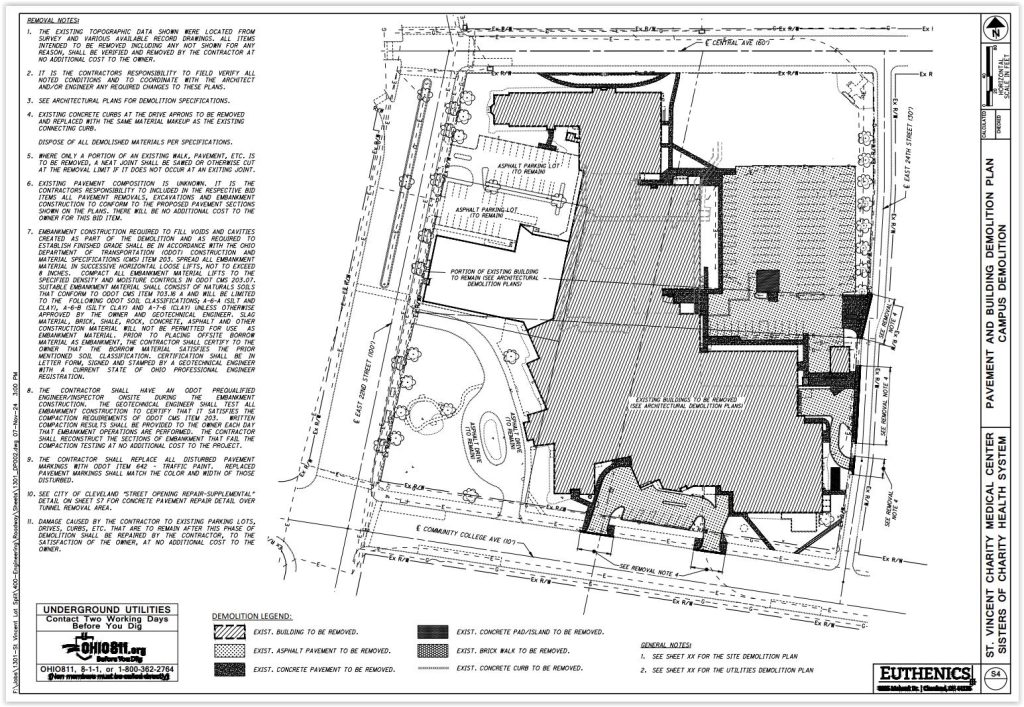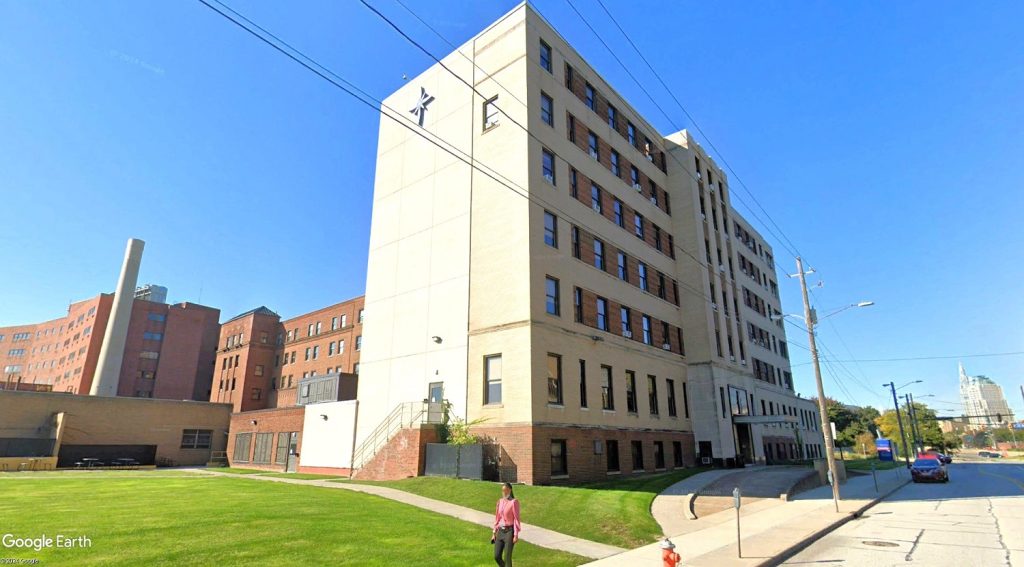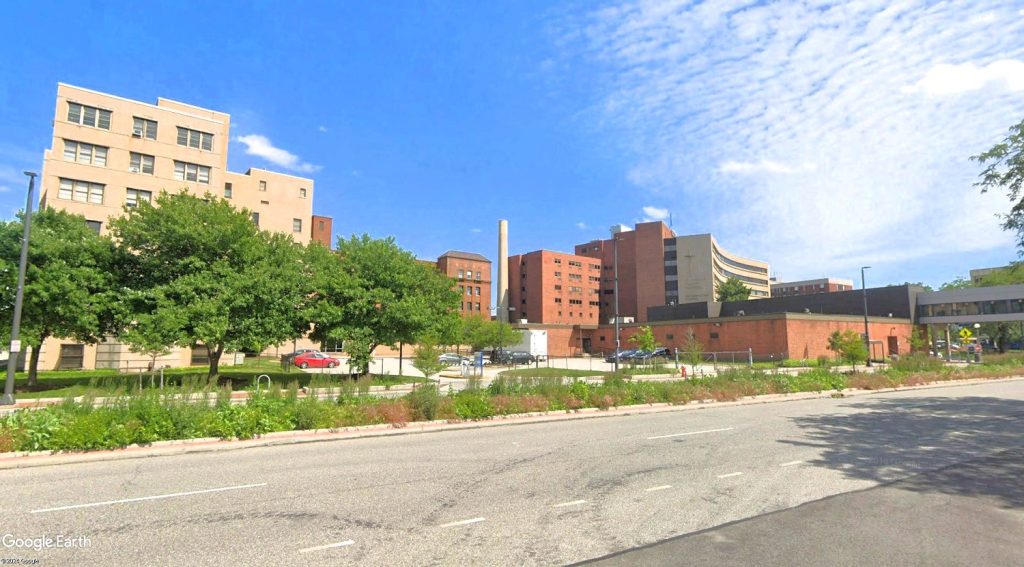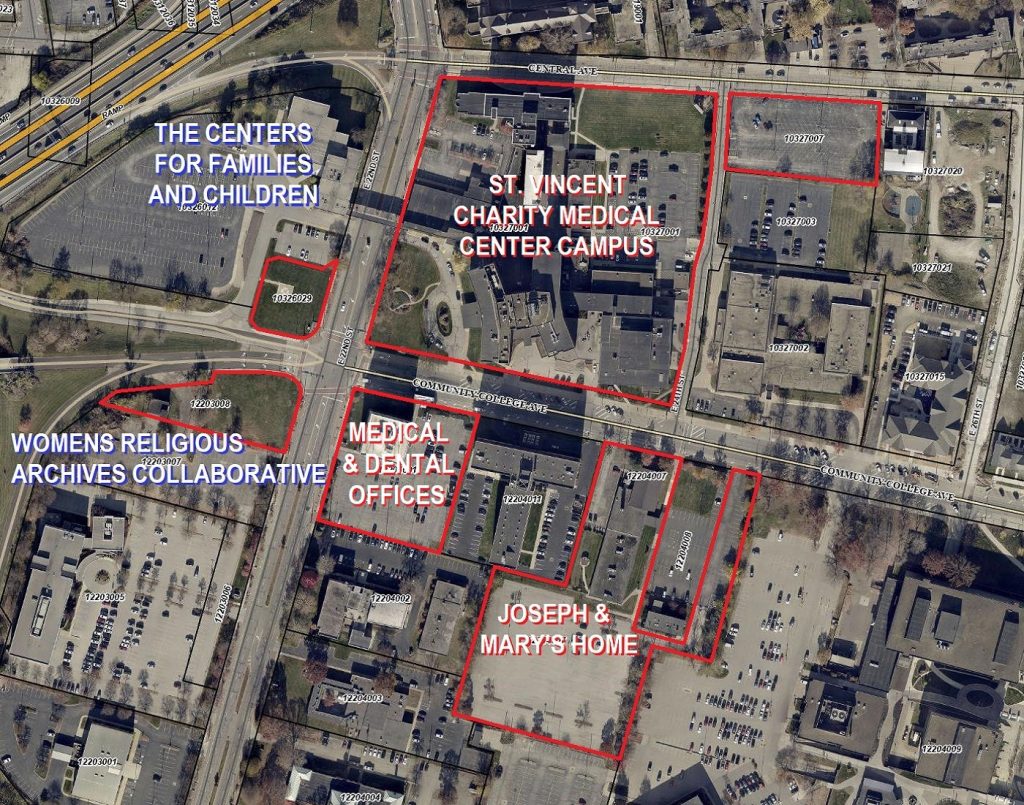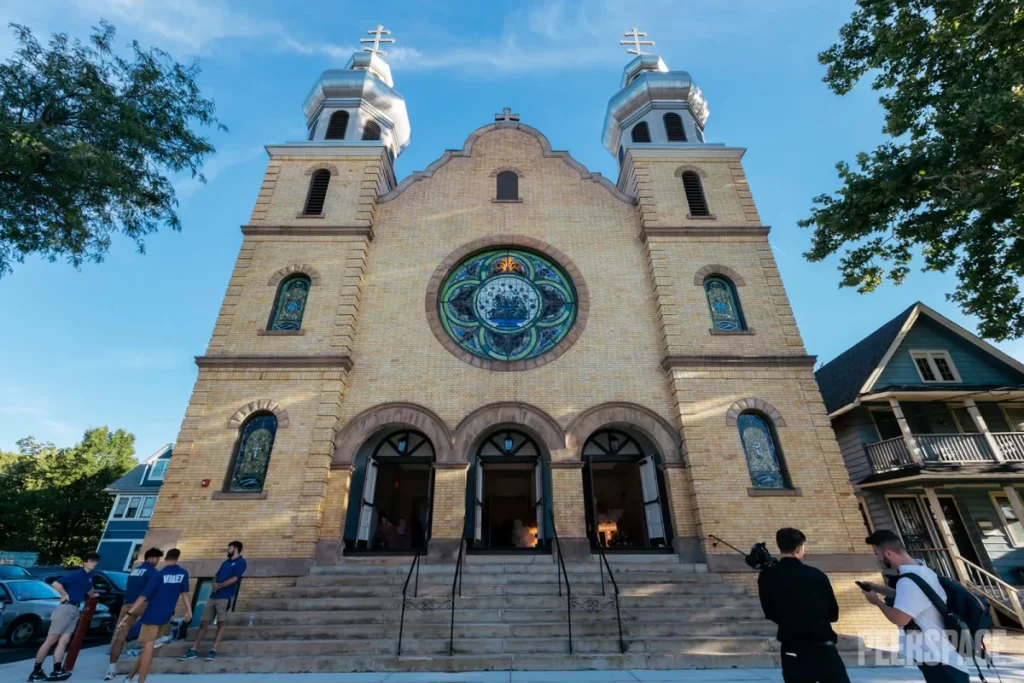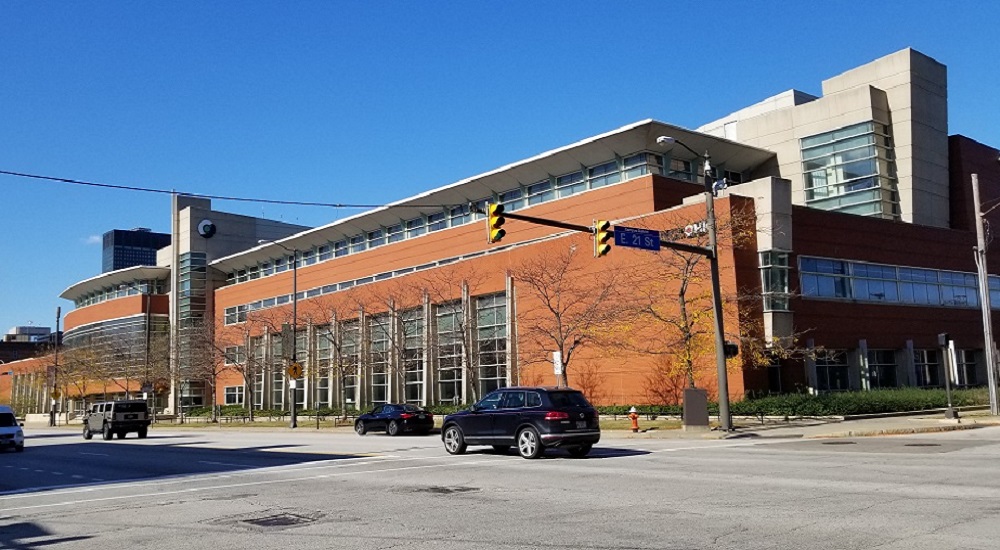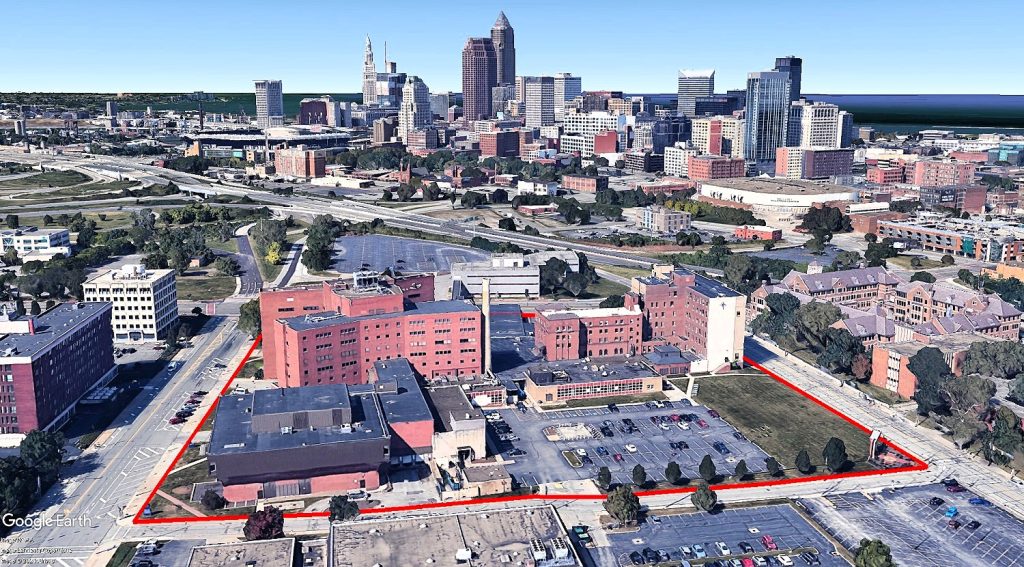
Outlined in red is the St. Vincent Charity Medical Center that will be demolished. The only structure within that outline that won’t be demolished is a small building on the other side of the near-Downtown Cleveland campus that is not visible from this angle. A streetview of that building is shown later in this article (Google). CLICK IMAGES TO ENLARGE THEM.
8-acre site joins others for future redevelopment
In just three years, St. Vincent Charity Medical Center, 2351 E. 22nd St,, went from planning a major expansion to requesting the demolition of nearly its entire main campus to the southeast of Downtown Cleveland. Plans were submitted to the city’s Building Department on Friday for demolishing all but 18,000 square feet of the 449,338-square-foot campus.
This follows the ending of the hospital’s inpatient care and closure of the emergency department in November 2022. The Sisters of Charity of St. Augustine has had a long history here, beginning in Cleveland in 1851 and founding the hospital in 1865. Ironically, the Sisters’ history will be preserved at a $13 million archives building to be constructed starting next year, one block south on East 22nd.
Outpatient care by St. Vincent Charity continues at two nearby facilities — a medical office building at 2475 E. 22nd plus Joseph & Mary’s Home at 2302 Community College Ave. The latter offers medical care for the homeless.
St. Vincent Charity spokesperson Mary Rose Sullivan said she would be able to provide comment and more information about the requested demolition after the weekend. The medical center is located at the west end of Cleveland’s Central neighborhood and is part of the Campus District. No plans have been released yet for its redevelopment.
“Demolition of all buildings on the St. Vincent Charity Medical Center campus (are requested) except for the HCC Building which will remain and be re-purposed in the future,” wrote Don Rerko, vice president of CPL Architecture Engineering Planning in its demolition permit application to the city. “Buildings are to be demolished, utilities capped, and (the) site brought to greenfield conditions.”
That includes removing all but one small parking lot on the 8.3-acre site and the 85,000-square-foot basement. Plans also show that the rose garden and monument at the southeast corner of Central Avenue and East 24th Street is to be preserved.
CPL Architecture Engineering Planning, which is based in suburban Berea, estimated that the cost of demolishing the hospital’s main campus would be about $4.5 million.
Most of the hospital’s existing main campus was built in the mid-1960s and renovated in 1993, Cuyahoga County property records show. The oldest structure on the campus is the seven-story, 93-year-old West Building in the 2200 block of Central.
On the ground floor of the West Building is the Spanish-designed, 300-seat Holy Trinity Chapel which was dedicated by Bishop Joseph Schrembs of the Cleveland Catholic Diocese on March 7, 1931.
“The chapel itself was part of the expansion of St. Vincent Charity in the late 1920s and early 1930s.” noted a 2021 posting in the hospital’s blog. “The expansion came about as part of a massive citywide, nine-day fundraising campaign in the spring of 1926, which raised over $1.5 million.”
Historic preservation consultant Steve McQuillin said the West Building and possibly the 1964-built, curving in-patient hospital building at East 22nd and Community College Avenue could have potential for National Register of Historic Places registration and protective status.
“It might be feasible for a conversion to residential or senior care that could take advantage of tax incentives,” McQuillin said. “The complex seems remote from downtown but perhaps Cleveland State might consider developing a residential campus that might reuse some buildings.”
Included in the St. Vincent Charity’s expansion 90-plus years ago was the ornate, 1927-built, former Charity Hospital Nurses Home that stood at 2320 E. 24th St. It was designed by noted Cleveland-based architectural firm George S. Rider Co. that was in business for 120 years until 2007. Despite that, it was not protected as a listed building.
It along with two neighboring hospital buildings were demolished in the 2010s for a $35 million surgery pavilion that was never built. That project was expected to create 1,248 jobs and retain 1,200 positions, according to the Ohio Development Services Agency which awarded a $1.9 million Clean Ohio Revitalization Fund grant for the demolition.
Instead, the only result was a swath of vacant land and a brick and stone arched doorway salvaged from the Nurses Home. The arch is the monument that adorns the rose garden at Central and East 24th.
The lone structure to be saved from the wrecking ball in the coming weeks and months is a mostly windowless brick building on East 22nd called the HCC Building, an ambulatory care center. HCC refers to a risk assessment called Hierarchical Condition Category. It’s a payment coding system used at emergency departments and mandated by the Centers for Medicare and Medicaid Services.
The 18,000-square-foot HCC Building and another across East 22nd, connected by an enclosed walkway over the street, were built in 1984. While the HCC Building will be mothballed for an unidentified future use, the building at the other end of the enclosed walkway has a new owner.
According to county property records, this 58,236-square-foot office building and its 4.8-acre parking lot were bought in March for $1.9 million by The Centers For Families And Children, dubbed The Centers.
The Centers is currently based at 4500 Euclid Ave. but offers social services at 20 locations in Greater Cleveland. Originally, The Centers originally sought to renovate its existing building for $10.8 million but discovered the East 22nd building could be renovated for half as much money.
By early 2026, the building at 2322 E. 22nd is due to be the new headquarters for The Centers. It will also provide integrated health care to people with behavioral health conditions, said The Centers President and CEO Eric Morse.
“The closing of St. Vincent’s Medical Center created a social services gap in the Central neighborhood,” Morse said in a written statement. “Our goal is to become an anchor institution by providing accessible, high-quality services that address the unique needs of the residents, joining with residents and community partners to foster a healthier and more vibrant community.”
St. Vincent Charity’s main campus isn’t the only building at the west end of Central subject to demolition. Across Central Avenue, the vacant, 1931-built Cuyahoga County Juvenile Justice Center, 2163 Cedar Ave., is to be demolished soon.
Once cleared, its 4.5-acre site will become a staging aging for construction equipment and materials for the Ohio Department of Transportation’s two-year, $250 million project to redesign and rebuild Interstate 90 in the Central Interchange area between East 9th Street and Carnegie Avenue.
After that, the site could figure into what may be the largest housing development in or near downtown. The Cuyahoga Metropolitan Housing Authority (CMHA) is seeking to replace its Olde Cedar housing projects, 2202 E. 30th St. — yet another pending demolition.

Even before the demolition of St. Vincent Charity Medical Center, shown here in dark gray, a large amount of land at the west end of the Central neighborhood closest to Downtown Cleveland is underutilized. And the top of this graphic ends at Central Avenue. On the other side of it is the Juvenile Justice Center and the Olde Cedar housing projects, both of which are to be demolished in the coming years (CPL).
Up to 900 mixed-income apartments are desired here, according to two real estate sources who spoke to NEOtrans and requested anonymity. Built in 1937, Olde Cedar is CMHA’s oldest active residential property and one of the oldest public housing projects in the United States.
When combining St. Vincent Charity Medical Center, the former Cuyahoga County Juvenile Justice Center and Olde Cedar, more than 30 acres of contiguous land will be bulldozed in the coming years and become a canvas for something new.
“We are working from the planning side of things on larger planning coordination in this area because there’s so many institutional partners,” said City Planning Director Joyce Pan Huang at a Nov. 1 planning commission meeting. “(There’s) so much potential here to reconnect Central to Downtown and Downtown to Central.”
END

